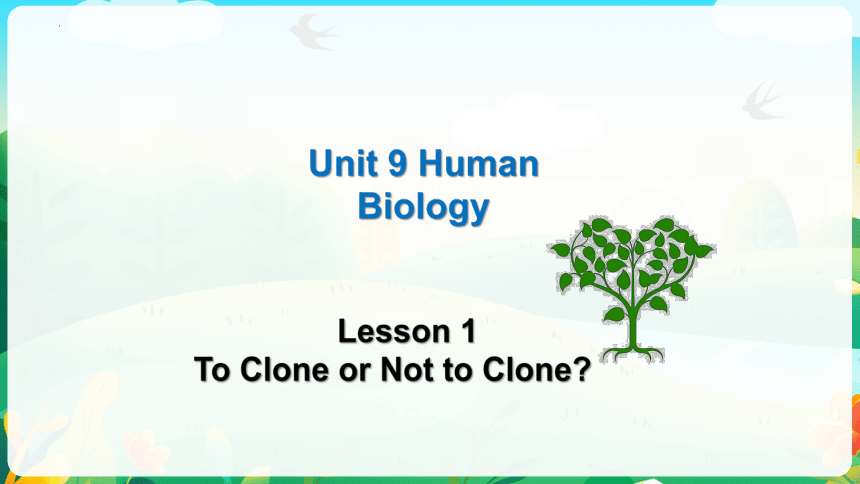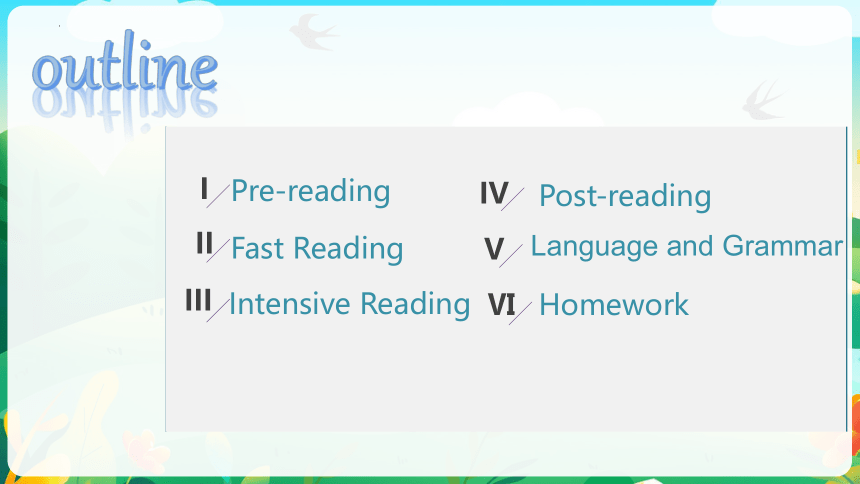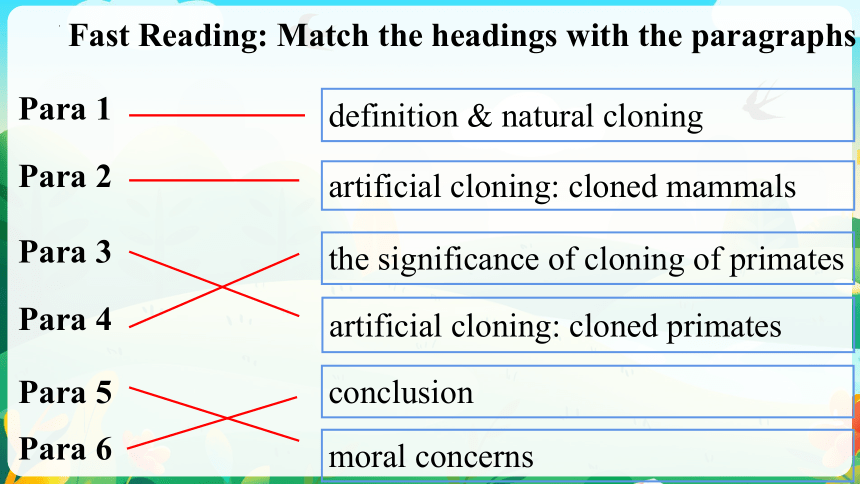北师大版(2019) 选择性必修第三册 Unit 9 Human Biology Lesson1 To Clone or Not to Clone课件(31张ppt)
文档属性
| 名称 | 北师大版(2019) 选择性必修第三册 Unit 9 Human Biology Lesson1 To Clone or Not to Clone课件(31张ppt) |  | |
| 格式 | pptx | ||
| 文件大小 | 567.0KB | ||
| 资源类型 | 教案 | ||
| 版本资源 | 北师大版(2019) | ||
| 科目 | 英语 | ||
| 更新时间 | 2022-09-26 22:23:58 | ||
图片预览









文档简介
(共29张PPT)
Unit 9 Human Biology
Lesson 1
To Clone or Not to Clone
Pre-reading
I
Post-reading
IV
Fast Reading
II
Language and Grammar
V
III
Intensive Reading
Ⅵ
Homework
outline
Ⅰ
Pre-reading
Cloning can create identical genes.
Cloning can be used to edit genes.
Cloning can make an exact copy of an animal.
Scientists have broken lots of technical barriers when studying cloning.
We’ve cloned several species, like sheep, cattle and dogs.
Scientists want to produce animal models that are helpful for medical research.
Pre-reading
What do you know about cloning
What additional information would you like to know
When was the first cloned animal created
Why are scientists so interested in cloning
What achievements have we made in cloning
What problems are we facing now
…
Pre-reading
Ⅱ
Fast Reading
definition & natural cloning
artificial cloning: cloned mammals
artificial cloning: cloned primates
the significance of cloning of primates
moral concerns
conclusion
Fast Reading: Match the headings with the paragraphs
Para 1
Para 2
Para 3
Para 4
Para 5
Para 6
Ⅲ
Intensive Reading
Intensive Reading
To clone or not to clone
definition
natural cloning
Para 1
artificial cloning
Para 2-4
cloned mammals
Para 2
cloned primates
Para 3
the significance of cloning of primates
Para 4
Draw a structural map to show how the paragraphs are organised.
Intensive Reading
To Clone or Not to Clone
moral concerns
Para 5
conclusion
Para 6
Draw a structural map to show how the paragraphs are organised.
Read the first four paragraphs to answer the following questions.
1. What was the first cloned mammal What happened to her
2. How has the science of cloning developed since the first cloned mammal
3. What development in cloning was announced in 2018 What was special about it
4. For how long did Dr. Sun Qiang’s team work Why did they work so hard
5. Why was it significant to clone primates
Intensive Reading
1. What was the first cloned mammal What happened to her
It was a sheep named Dolly in 1996.
At first, Dolly grew normally. But later she developed an illness that is more normally found in much older animals. She lived for six and a half years, only half the life of the sheep from which she was cloned.
Intensive Reading
2. How has the science of cloning developed since the first cloned mammal
After Dolly, scientists have cloned more than 20 mammal species, including camels, cattle, deer, dogs, goats, and mice.
Intensive Reading
3. What development in cloning was announced in 2018 What was special about it
In January 2018, Chinese scientists announced the cloning of two long-tailed monkeys, Zhong Zhong and Hua Hua. They were the first-ever primates to have been cloned! Cloning primates is much harder and doing so with non-reproductive cells was even more complicated.
Intensive Reading
Zhong Zhong and Hua Hua
Intensive Reading
4. For how long did Dr. Sun Qiang’s team work Why did they work so hard
They worked 24 hours a day, 7 days a week for more than 5 years.
They wanted to get animals with edited genes and produce animal models that are helpful for medical research and human health.
Intensive Reading
Dr. Sun Qiang and one of his team members
Intensive Reading
5. Why was it significant to clone primates
It might lead to cures for various diseases.
It may offer clues on how to prevent the aging process.
It allows us to have the potential to raise a large number of monkeys with identical genes in a short amount of time.
It may allow us to change their genes to suit research needs.
It could help save research time.
Intensive Reading
5. Why was it significant to clone primates
It could reduce the number of animals required for testing.
It could produce more accurate results.
It could lead to more effective treatments.
Intensive Reading
Potential benefits
will lead to cures for various diseases
Intensive Reading
Read paragraphs 5 and 6. Finish the columns.
prevent aging, save research time, reduce the number of animals being tested on, producing more accurate results, better treatments
Moral concerns
has refreshed the technical possibility of cloning of other species
Intensive Reading
clones should be treated as objects or individuals, clones are inferior, some organisations may abuse the technology
Read paragraphs 5 and 6. Finish the columns.
What does Einstein’s quote mean
“Science is a powerful instrument. How it is used, whether it is a blessing or a curse to mankind, depends on mankind and not on the instrument. A knife is useful, but it can also kill.”
Intensive Reading
Science itself cannot be judged as good or bad, because
it can only function when it is used by humans. Humans need to be careful with the information they learn through science and to remember to use science for good.
Ⅳ
Post-reading
Natural cloning has taken place for generations. An example of this is identical 1 _____. A sheep called Dolly was the first mammal to be cloned 2 __________. Since Dolly, more than 20 mammal 3 _______ have been cloned including camels and goats. In 2018, China announced that two monkeys had been cloned. In comparison with other species, scientists have had to work hard to break the technical 4 _______ to get primates with 5 _______ genes.
twins
artificially
species
barriers
edited
Complete the summary using the information in the article.
Post-reading
Scientists say that this major breakthrough offers the 6 ________ to create monkeys with 7 __________ genes to give more 8 ________ research results and perhaps lead to 9 _____ for various diseases. Whilst scientists insist it is 10 ______ to continue research, others raise 11 _____ concerns and worry that the technology might be 12 _______ by some organisations.
potential
identical
accurate
cures
crucial
moral
abused
Post-reading
1. Why do researchers insist that the science of cloning should be further explored and advanced
Post-reading: Think and share
Researchers insist on exploring cloning to continue making progress in curing diseases and developing
treatments.
2. What is the writer’s attitude towards cloning Find evidence.
Post-reading: Think and share
The writer feels that cloning can be a helpful tool in medical research but that it can also become dangerous. Evidence of this is in the writer’s use of Einstein’s quote.
VI
Homework
Search online and find more information about the development of cloning.
Homework
Unit 9 Human Biology
Lesson 1
To Clone or Not to Clone
Pre-reading
I
Post-reading
IV
Fast Reading
II
Language and Grammar
V
III
Intensive Reading
Ⅵ
Homework
outline
Ⅰ
Pre-reading
Cloning can create identical genes.
Cloning can be used to edit genes.
Cloning can make an exact copy of an animal.
Scientists have broken lots of technical barriers when studying cloning.
We’ve cloned several species, like sheep, cattle and dogs.
Scientists want to produce animal models that are helpful for medical research.
Pre-reading
What do you know about cloning
What additional information would you like to know
When was the first cloned animal created
Why are scientists so interested in cloning
What achievements have we made in cloning
What problems are we facing now
…
Pre-reading
Ⅱ
Fast Reading
definition & natural cloning
artificial cloning: cloned mammals
artificial cloning: cloned primates
the significance of cloning of primates
moral concerns
conclusion
Fast Reading: Match the headings with the paragraphs
Para 1
Para 2
Para 3
Para 4
Para 5
Para 6
Ⅲ
Intensive Reading
Intensive Reading
To clone or not to clone
definition
natural cloning
Para 1
artificial cloning
Para 2-4
cloned mammals
Para 2
cloned primates
Para 3
the significance of cloning of primates
Para 4
Draw a structural map to show how the paragraphs are organised.
Intensive Reading
To Clone or Not to Clone
moral concerns
Para 5
conclusion
Para 6
Draw a structural map to show how the paragraphs are organised.
Read the first four paragraphs to answer the following questions.
1. What was the first cloned mammal What happened to her
2. How has the science of cloning developed since the first cloned mammal
3. What development in cloning was announced in 2018 What was special about it
4. For how long did Dr. Sun Qiang’s team work Why did they work so hard
5. Why was it significant to clone primates
Intensive Reading
1. What was the first cloned mammal What happened to her
It was a sheep named Dolly in 1996.
At first, Dolly grew normally. But later she developed an illness that is more normally found in much older animals. She lived for six and a half years, only half the life of the sheep from which she was cloned.
Intensive Reading
2. How has the science of cloning developed since the first cloned mammal
After Dolly, scientists have cloned more than 20 mammal species, including camels, cattle, deer, dogs, goats, and mice.
Intensive Reading
3. What development in cloning was announced in 2018 What was special about it
In January 2018, Chinese scientists announced the cloning of two long-tailed monkeys, Zhong Zhong and Hua Hua. They were the first-ever primates to have been cloned! Cloning primates is much harder and doing so with non-reproductive cells was even more complicated.
Intensive Reading
Zhong Zhong and Hua Hua
Intensive Reading
4. For how long did Dr. Sun Qiang’s team work Why did they work so hard
They worked 24 hours a day, 7 days a week for more than 5 years.
They wanted to get animals with edited genes and produce animal models that are helpful for medical research and human health.
Intensive Reading
Dr. Sun Qiang and one of his team members
Intensive Reading
5. Why was it significant to clone primates
It might lead to cures for various diseases.
It may offer clues on how to prevent the aging process.
It allows us to have the potential to raise a large number of monkeys with identical genes in a short amount of time.
It may allow us to change their genes to suit research needs.
It could help save research time.
Intensive Reading
5. Why was it significant to clone primates
It could reduce the number of animals required for testing.
It could produce more accurate results.
It could lead to more effective treatments.
Intensive Reading
Potential benefits
will lead to cures for various diseases
Intensive Reading
Read paragraphs 5 and 6. Finish the columns.
prevent aging, save research time, reduce the number of animals being tested on, producing more accurate results, better treatments
Moral concerns
has refreshed the technical possibility of cloning of other species
Intensive Reading
clones should be treated as objects or individuals, clones are inferior, some organisations may abuse the technology
Read paragraphs 5 and 6. Finish the columns.
What does Einstein’s quote mean
“Science is a powerful instrument. How it is used, whether it is a blessing or a curse to mankind, depends on mankind and not on the instrument. A knife is useful, but it can also kill.”
Intensive Reading
Science itself cannot be judged as good or bad, because
it can only function when it is used by humans. Humans need to be careful with the information they learn through science and to remember to use science for good.
Ⅳ
Post-reading
Natural cloning has taken place for generations. An example of this is identical 1 _____. A sheep called Dolly was the first mammal to be cloned 2 __________. Since Dolly, more than 20 mammal 3 _______ have been cloned including camels and goats. In 2018, China announced that two monkeys had been cloned. In comparison with other species, scientists have had to work hard to break the technical 4 _______ to get primates with 5 _______ genes.
twins
artificially
species
barriers
edited
Complete the summary using the information in the article.
Post-reading
Scientists say that this major breakthrough offers the 6 ________ to create monkeys with 7 __________ genes to give more 8 ________ research results and perhaps lead to 9 _____ for various diseases. Whilst scientists insist it is 10 ______ to continue research, others raise 11 _____ concerns and worry that the technology might be 12 _______ by some organisations.
potential
identical
accurate
cures
crucial
moral
abused
Post-reading
1. Why do researchers insist that the science of cloning should be further explored and advanced
Post-reading: Think and share
Researchers insist on exploring cloning to continue making progress in curing diseases and developing
treatments.
2. What is the writer’s attitude towards cloning Find evidence.
Post-reading: Think and share
The writer feels that cloning can be a helpful tool in medical research but that it can also become dangerous. Evidence of this is in the writer’s use of Einstein’s quote.
VI
Homework
Search online and find more information about the development of cloning.
Homework
